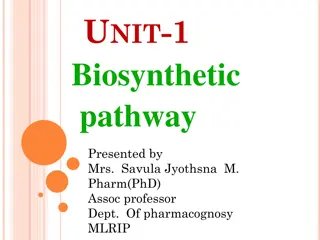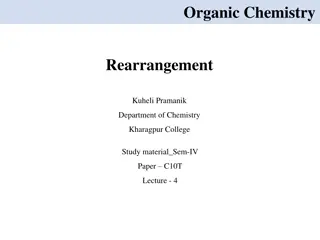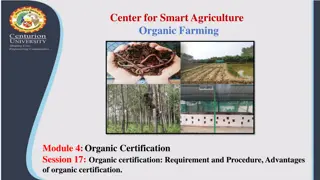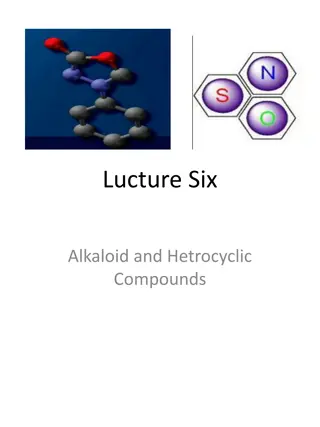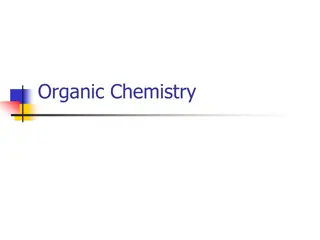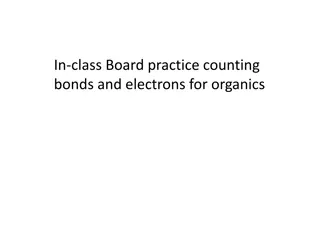Understanding Organic Compounds and Their Importance in Daily Life
Explore the world of organic compounds, including their definition, difference from inorganic compounds, common elements found in them, and the significance of hydrocarbons. Learn about the essential role of organic compounds in living organisms, such as proteins, carbohydrates, and fats, and how they are vital for sustaining life. Dive deeper into carbohydrates, their types, and their function in providing energy to the body. Gain insights into the basic outline of commonly consumed substances and their impact on overall health.
Download Presentation

Please find below an Image/Link to download the presentation.
The content on the website is provided AS IS for your information and personal use only. It may not be sold, licensed, or shared on other websites without obtaining consent from the author. Download presentation by click this link. If you encounter any issues during the download, it is possible that the publisher has removed the file from their server.
E N D
Presentation Transcript
Organic Compounds What is it? What is the difference between Inorganic and Organic compounds? Organic Compounds are found in: carbohydrates, lipids, protein, and nucleic acids.
What is a organic compound? An organic compound is any member of a large class of gaseous, liquid, or solid chemical compounds whose molecules contain carbon. Chemists use organic compounds vs inorganic compounds to identify CARBON vsnoncarbon compounds.
Whats the common element in these substances? Acetoguanamine - C4H7N5 Acetone CH3COCH3, or (CH3)2CO Acetonitrile - C2H3N Acetophenone - C8H8O Acetylcholine (CH3)3N+CH2CH2OCOCH3. Acetylene C2H2
Hydrocarbons! The simplest Organic compounds are made up of only Carbon and Hydrogen atoms only. Even these run into thousands! Compounds of Carbon and Hydrogen only are called Hydrocarbons.
Most organic compounds are In living organisms Some are Proteins Carbohydrates Fats (lipids) ESSESNTIALLY ORGANIC COMPOUNDS ARE VITAL FOR LIFE! By the end of this lesson, you ll be able to identify the picture above
Basic Outline of what most people consume: By the end of this lesson, you ll understand how each of these work in your body!
Deep look into: Carbohydrates Why? A carbohydrate is basically a sugar Sugars provide living organisms with energy Most foods we eat contain carbohydrates Our bodies break down carbohydrates into simple sugars
Types of Carbohydrates Simple Carbohydrates Found in refined sugars (processed foods) Broken down quickly by the body to be used as energy Should not be the main source of Carbohydrates Lacks vitamins, minerals and fibers Found naturally in foods like fruits, milk and milk products.
Glucose- Simple Sugar Facts Cells use glucose for their primary source of energy (Major source of energy!) Turns sugar into energy Known as the grape sugar, blood sugar or corn sugar as these are its riches sources. Listed in food ingredients as dextrose.
Fructose Simple Sugar Fruit sugar- found in many plant cells Fructose is from sugar cane Fructose is sweet Does not cause your blood sugar to rise like glucose In many fruits Is made artificially
Sucrose- Simple Sugar Major product of photosynthesis, the process by which plants transform the sun's energy into food. AKA TABLE SUGAR Is made with the linkage of both glucose and fructose! Is a white oderless powder Sugar or more specifically sucrose is a carbohydrate that occurs naturally in every fruit and vegetable. I
Why are simple sugars so important? A lot of health experts advocate limiting these simple sugars because they cause: Most people should get between 40% and 60% of total calories from carbohydrates! Sometimes simple sugars are seen as the bad sugars
Deep look into. Complex Carbohydrates -Complex carbohydrates are chains of three or more single sugar molecules linked together. -Long chains of sugar molecules called starches serve as a storage form of energy -Foods with large amounts of complex carbohydrates include legumes, starchy vegetables like potatoes and corn, rice and grain products- -When you think of complex carbohydrates, starches should come into your mind -They take the longest to digest. -Many contain fiber -The body has to break down all sugar/starch into glucose to use it. Starch supplies the body with long, sustained energy.
So.what is starch? Starch or amylum is a carbohydrate consisting of a large number of glucose (simple sugar, remember??) units joined together by glycosidic bonds. Starch is essential for long term energy We can tes
Monosaccharide Monosaccharidesare the most basic units of biologically important carbohydrates. They are the simplest form of sugar and are usually colorless, water-soluble, crystalline solids xamples of monosaccharides include glucose and Fructose fructose Like Simple Carbohydrates Just a different name!
Disaccharide A disaccharide is a carbohydrate formed when two monosaccharides undergo a condensation reaction which involves the elimination of a small molecule, such as water, from the functional groups only. Like Complex Carbohydrates.. Just a different name!
Polysaccharides Polysaccharides are polymeric carbohydrate structures, formed of repeating units (either mono- or di- saccharides) joined together by bonds. CHAOS
Benedicts Solution Benedict's reagent is used as a test for the presence of reducing sugars. This includes all monosaccharides and disaccharides
Lipids Lipids constitute a broad group of naturally occurring molecules which include fats, waxes, sterols, fat-soluble vitamins Unlike Carbohydrates, lipids ARE NOT used as fast as an energy source as Carbohydrates They take much longer to use as energy How are lipids made? Fats and oils are made from two kinds of molecules: glycerol (a type of alcohol with a hydroxyl group on each of its three carbons) and three fatty acids joined by dehydration synthesis. These two compounds put together are known as: Triglycerides We have two types of fats: Saturated Fats and Unsaturated Fats
How is a lipid made? A lipid contains ONE glycerin with three long fatty acid chains The fatty acids are the components removed from the glycerol head and used for energy and storage in the cell. Glycerol is a small alcohol molecule that attaches to the second part of the lipid structure--the fatty acid chains.
Saturated Fats What? Saturated fat is fat that consists of triglycerides containing only saturated fatty acids. From? The majority of saturated fats come mainly from animal sources, including meat and dairy products
Saturated Fats have no double bonds A fat that is solid at room temperature and comes chiefly from animal food products. Examples are butter, lard, meat fat, solid shortening, palm oil, and coconut oil. These fats tend to raise the level of cholesterol in the blood. Do saturated fats have bonds? -Saturated Fats in our diets -Sometimes the bad fat
Unsaturated Fats An unsaturated fat is a fat or fatty acid in which there is at least one double bond within the fatty acid chain. Studies show that eating foods rich in monounsaturated fats (MUFAs) improves blood cholesterol levels, which can decrease your risk of heart disease Foods made up mostly of monounsaturated and polyunsaturated fats are liquid at room temperature, such as olive oil, safflower oil, peanut oil and corn oil.
CIS VS TRANS Unsaturated fats can have double bonds being either cis or trans. Double bonds may be in either a cis or a trans isomer, depending on the geometry of the double bond. In the cis conformation, hydrogen atoms are on the same side of the double bond, whereas, in the trans conformation, they are on opposite sides. Do you see the difference?
Unsaturated Fats Have Double Bonds To be unsaturated, you would have a double bonds. You can have one bond breaking up, or multiple bonds
Types of Unsaturated Fats A fat molecule is monounsaturated if it contains one double bond, and polyunsaturated if it contains more than one double bond.
Transfat What is it? What does this do? Is this saturated? Is this unsaturated?
Nutritional Information Trans fats are not essential fatty acids. The consumption of trans fats increases the risk of coronary heart disease[1][2] by raising levels of LDL cholesterol and lowering levels of "good" HDL cholesterol Trans fats are often looked down upon as the bad fats and are seen as worse compared to Saturated Fats
Common Definition and analysis of Trans fat Trans fat is the common name for unsaturated fat with trans-isomer fatty acid(s). Because the term refers to the configuration of a double carbon-carbon bond, trans fats are sometimes monounsaturated or polyunsaturated, but neversaturated.
Hydrophobic vs. Hydrophilic Hydrophobic -Water fearing -Hydrophobic molecules tend to be non-polar and thus prefer other neutral molecules and non- polar solvents. -tending not to dissolve in, mix with, or be wetted by water Hydrophilic -water loving. -Such compounds have an affinity to water and are usually charged or have polar side groups to their structure that will attract water. -Hydrophilic substances are attracted to, and dissolve well within, water.
Hydrophobic- Examples of Hydrophobic vs. Hydrophilic Hydrophilic
Deep Look Into Proteins! Many foods contain protein, but the best sources are beef, poultry, fish, eggs, dairy products, nuts, seeds, and legumes like black beans and lentils. Protein builds up, maintains, and replaces the tissues in your body. Did you know your body uses protein to make hemoglobin (the part of red blood cells that carries oxygen to every part of your body). Other proteins are used to build cardiac muscle.
Types of Proteins: Transmembrane protein -protein that goes from one side of a membrane through to the other side of the membrane -It is embedded between the phospholipids, providing a channel through which molecules and ions can pass into the cell. -Transmembrane proteins also facilitate communication between cells by interacting with chemical messengers. Integral Membrane Protein -An integral membrane protein (IMP) is a protein molecule (or assembly of proteins) that is permanently attached to the biological membrane. MPs include transporters, channels, receptors, enzymes, structural membrane- anchoring domains, proteins involved in accumulation and transduction of energy
Proteins...where, what?! Proteins are part of the cell membrane Proteins have an essential function to our cells and essentially our bodies! Most proteins consist of linear polymers built from series of up to 20 different L- -amino acids. All proteinogenic amino acids possess common structural features, including an -carbon to which an amino group, a carboxyl group, and a variable side chain are bonded.
Protein Folding Failure to fold into native structure produces inactive proteins that are usually toxic Protein folding is the physical process by which a polypeptide folds into its characteristic and functional three- dimensional structure from random coi
What makes up Proteins? AMINO ACIDS!! Each protein has its own unique amino acid sequence that is specified by the nucleotide sequence of the gene encoding this protein. Our body has 20 different types of Amino Acids!
Do you see the structures that make this structure an Amino Acid? Amino Acids Some basic Information: Amino acids are the building blocks of proteins. All amino acids have a central or alpha carbon, to which are bonded 4 groups: a hydrogen an amino group a carboxyl group a unique side chain, also known as a R-group
Essential Amino Acids An essential amino acid or indispensable amino acid is an amino acid that cannot be synthesized de novo by the organism (usually referring to humans), and therefore must be supplied in the diet. Nonessential Amino Acids Non essential amino acids are amino acids that can be produced in our body. Their uses and functions in our body are equally as important as the limiting amino acids.
Essential Amino Acids Isoleucine Leucine Lysine Methionine Phenylalanine Threonine Tryptophan Valine
Nonessential Amino Acids Alanine Asparagine Aspartic Acid Cysteine Glutamic Acid Glutamine Glycine Proline Serine Tyrosine Arginine Histidine Just a Reminder
What Makes Amino Acids Organic? The Carbon Compound!
Nucleic Acids What is Nucleic Acids? Do you think these are important for the development and structure of life? Have you ever heard of Nucleic Acids? What does this even do?!
The term nucleic acid is the overall name for DNA and RNA, members of a family of biopolymers,[6] and is synonymous with polynucleotide. Nucleic acids were named for their initial discovery within the cell nucleus, and for the presence of phosphate groups (related to phosphoric acid) Nucleic Acid A description The nucleic acids are the building blocks of living organisms. You may have heard of DNA described the same way. Guess what? DNA is just one type of nucleic acid. Some other types are RNA, mRNA, and tRNA Nucleic acids are biological molecules essential for life, and include DNA (deoxyribonucleic acid) and RNA (ribonucleic acid).
Nucleic Acids Structure These nucleotides are made of three parts. 1. A five carbon sugar 2. A base that has a nitrogen (N) atom 3. An ion of phosphoric acid Now you try drawing one!
We only need 5 Nucleotides to Survive! The five pieces are Uracil, Cytosine, Thymine, Adenine, and Guanine. DNA sequence! These always go together in chains of: For DNA: G=C A=T For RNA: A=T G=U
What else does Carbon do? Carbon dioxide is essential to photosynthesis in plants and other photoautotrophs, and is also a prominent greenhouse gas In 2009, the CO2 global average concentration in Earth's atmosphere was about 0.0387% by volume
Break down of what is in the Earth:
The Carbon Cycle The carboncycle is the biogeochemical cycle by which carbon is exchanged among the biosphere, pedosphere, geosphere, hydrosphere, and atmosphere of the Earth. It is one of the mostimportant cycles of the earth and allows for carbon to be recycled and reused throughout the biosphere and all of its organisms





